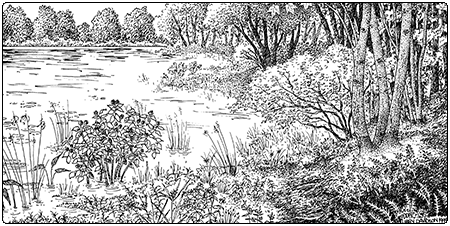Ecology and Physical Setting 
Outwash Plain Pondshore is a rare community in Vermont, with only one site currently known: Lily Pond in Vernon. This community is similar to the coastal plain pondshores of the Atlantic coast. Like these coastal communities, our Vermont example is located in an area of glacial outwash. These deep sand and gravel deposits left by the retreating glaciers are very porous, so the groundwater table can drop substantially over the summer. For ponds located in glacial outwash plains, the result is a significant lowering of the pond water level over the course of the summer and an exposure of wide, muddy to sandy shores. Water level fluctuation varies from year to year. In years of drought, water levels may drop significantly, exposing a wide shoreline. In especially wet years, however, pond water levels may stay nearly constant with little shoreline substrate exposed.
Vegetation
The vegetation in Outwash Plain Pondshores is adapted to the irregularly fluctuating water levels that are characteristic of these ponds. Many of the plants present are annuals whose seeds remain dormant in the muddy substrate until they are exposed in years when water levels recede. There is distinct zonation of vegetation within this community, defined by substrate elevation relative to water levels.
Some characteristic plants of the exposed shoreline include three-way sedge, olive spikerush, pipewort, brownfruit rush, meadow beauty, golden pert, toothed cyperus, and autumn fimbristylis. Many of these plants are rare in Vermont, but are more common in Atlantic coastal plain pondshores. At the upper edges of the exposed muddy substrate, marsh fern may be common. Highbush blueberry, silver maple, and occasional black gum trees occur at the upper edge of the shore. Above this, there is a sharp transition to upland forest. Buttonbush occurs in patches at the deeper end of the exposed shore, along with pickerelweed. Below this, there is a gradual transition to floating-leaved aquatic communities and open water.
Wildlife Habitat
The permanent water of Lily Pond, and the seasonally exposed and vegetated shoreline, support several common reptiles and amphibians. Painted turtles may be seen basking on logs or on hummocks. Bullfrogs and green frogs use the shoreline vegetation and the open water. Spotted sandpipers, great blue herons, and green herons use the shoreline for hunting and feeding. Three odonates are associated with coastal plain pondshores, and all three are at or near the northern limits of their ranges in Vermont. One of these three is an uncommon dragonfly, petite emerald, that is also found at some peatland sites. The other two are rare damselflies, New England bluet and scarlet bluet.
Related Communities
- Basin Shrub Swamp also has high spring water levels that slowly recede during the growing season. Basin Shrub Swamps occur in small isolated basins, generally lack permanent standing water, and are characterized by buttonbush, winterberry holly, and other shrubs.
Conservation Status and Management Considerations
This is one of Vermont’s rarest communities. The one known Vermont example is only partially conserved. Particular threats to this community include alteration of the natural water regimes that could result from changing flows in the outlet stream, additional shoreline development, and use of off-road vehicles on the exposed muddy shores. Additional inventory of pondshores in appropriate landscape settings may reveal other examples of this community type in Vermont.
Distribution/Abundance 
Vermont’s only known example of this community is in Vernon. Closely related communities occur in coastal areas from Nova Scotia south to the mid-Atlantic.
Characteristic Plants
Shrubs
Occasional to Locally Abundant Species
Buttonbush – Cephalanthus occidentalis
Herbs
Abundant Species
Three-way sedge – Dulichium arundinaceum
Olive spikerush – Eleocharis flavescens var. olivacea
Pipewort – Eriocaulon aquaticum
Occasional to Locally Abundant Species
Brownfruit rush – Juncus pelocarpus
Meadow beauty – Rhexia virginica
Golden pert – Gratiola aurea
Toothed cyperus – Cyperus dentatus
Autumn fimbristylis – Fimbristylis autumnalis
Three-square – Schoenoplectus pungens
Marsh fern – Thelypteris palustris
Non-native Invasive Plants
Purple loosestrife – Lythrum salicaria
Rare and Uncommon Plants
Meadow beauty – Rhexia virginica
Autumn fimbristylis – Fimbristylis autumnalis
Olive spikerush – Eleocharis flavescens var. olivacea
Lance-leaved violet – Viola lanceolata
Marsh mermaid-weed – Proserpinaca palustris
Redtop panic grass – Coleataenia rigidula
Small-headed white aster – Symphyotrichum racemosum
Associated Animals
American bullfrog – Lithobates catesbeianus
Green frog – Lithobates clamitans
Painted turtle – Chrysemys picta
Mink – Neovison vison
Great blue heron – Ardea herodias
Green heron – Butorides virescens
Spotted sandpiper – Actitis macularius
Rare and Uncommon Animals
Petite emerald – Dorocordulia lepida
New England bluet – Enallagma laterale
Scarlet bluet – Enallagma pictum
Places to Visit
Lily Pond, Vernon, accessible by canoe or kayak from the town boat launch.
